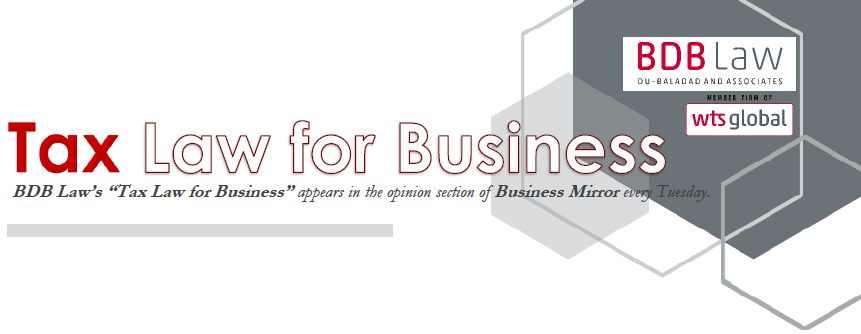
ASSESSMENT UNPLUGGED: Solving the BIR Audit Conundrum (Part I)
By Atty. Lino Ernie M. Guevara
"Knowing and understanding better the assessment procedure is still your best starting defense when assessed or hit by a BIR audit. The key is to know and also, to ask the right questions."
It’s that time of year.
Amidst the global maelstrom whipped up by the COVID-19 pandemic, its timing coinciding with our tax season makes it all the more taxing. It’s a welcome relief that the BIR, after its initial refusal, relented to extend the April 15 filing of the 2019 Annual ITR to May 15, 2020 sans any penalties. Likewise, the BIR through its Circulars and Operations Memorandum extended the filings of certain documents like protest letters and suspended the conduct of any field audit/investigation as well as prohibited personal service of electronic Letter of Authorities and the likes, but not assessment notices, during the enhanced community quarantine. Note though that only personal service is expressly prohibited with other modes of service, such as registered mail, still available. Service of assessment notices are not prohibited, and thus, may still possible.
 Hence, companies may still have to watch out for that dreaded Formal Letter of Demand and Assessment Notice (FLD/FAN) due to prescribing cases by April 15, 2020. Under our Tax Code, the BIR can assess, that is, by issuing the FLD/FAN, “within three (3) years after the last day prescribed by law for the filing of the return” (but extendible to ten (10) years under certain cases, e.g., fraudulent or false returns). Extension of the period to assess can only be done through a legislative amendment, not merely by a BIR issuance. Ergo, the BIR’s march to assess prescribing cases, COVID or no COVID, can neither be contained nor quarantined.
Hence, companies may still have to watch out for that dreaded Formal Letter of Demand and Assessment Notice (FLD/FAN) due to prescribing cases by April 15, 2020. Under our Tax Code, the BIR can assess, that is, by issuing the FLD/FAN, “within three (3) years after the last day prescribed by law for the filing of the return” (but extendible to ten (10) years under certain cases, e.g., fraudulent or false returns). Extension of the period to assess can only be done through a legislative amendment, not merely by a BIR issuance. Ergo, the BIR’s march to assess prescribing cases, COVID or no COVID, can neither be contained nor quarantined.
So, what to do if you’re “lucky” to receive that dreaded assessment notice from the BIR?
I am certain you have already been bombarded with lots of tips and advice before but there’s no harm in adding to your stockpile of armaments. Knowing and understanding better the assessment procedure is still your best starting defense when assessed or hit by a BIR audit. The key is to know and also, to ask the right questions.
Electronic Letter of Authority (eLA or L/A)
A taxpayer’s assessment travails commence with the BIR’s issuance of an eLA. It authorizes the BIR to examine the Company’s books of accounts, records and documents. It serves as the initial salvo by the BIR giving you a checklist of documents to commence their examination. A word of caution. Do not ignore the BIR’s repeated demand to submit documents as doing so may trigger the issuance of a Subpoena Duces Tecum -- a legal order for you to “bring” or produce the documents strictly within a prescribed period. Further, one effect of the eLA issuance is that you can no longer amend tax returns for the period covered, even that of a tentative tax return.
As ruled by the Supreme Court and echoed by the BIR in its issuance, any tax assessment issued without a Letter of Authority is a violation of the taxpayer's right to due process and, is therefore, "inescapably void."
Remember the general rule: No L/A or eLA, no valid assessment.
Questions to Ask:
• Was a valid eLA issued to the Company for the covered period being examined?
• Does the eLA bear the name, designation and signature of the approving BIR official?
• Does it contain a system-generated serial number and the date?
• Were the names of the Revenue Officers assigned printed on said eLA?
• Does it reflect the tax types and taxable period to be covered by the audit?
• Does it indicate the basis for the audit (i.e., regular audit program, special audit, etc.)?
• Does it have any manually-written character, notation or erasure rendering it void?
• Was it properly served by the BIR and was received by the Company’s authorized personnel?
Notice for Informal Conference (NIC)
Starting February 2018, the requirement for the BIR to issue a NIC was reinstated after having been previously dispensed with in 2013 by going straight to the issuance of a Preliminary Assessment Notice (PAN). During the "Informal Conference" stage, the taxpayer has the opportunity to present his explanations, which shall not extend beyond thirty (30) days from receipt of the notice. If still found to be liable and the taxpayer is not amenable with the findings, the case will then be endorsed for PAN issuance.
NIC is part of the taxpayer’s due process requirement. Hence, no NIC, no valid assessment.
Questions to Ask:
• Was a Notice for Informal Conference issued prior to the issuance of the PAN?
• Was the Company given the opportunity by the BIR to explain the initial findings within the prescribed period of at least 30 days from receipt of NIC?
Preliminary Assessment Notice
After the NIC, the BIR issues the PAN showing the facts and the law, rules and regulations, or jurisprudence on which the proposed assessment is based. Failure of the taxpayer to reply to the PAN within fifteen (15) days from date of receipt, will make him in default, so that the FLD/FAN shall be issued. Now, if he responds within15 days disagreeing with the findings, the FLD/FAN shall be issued within 15 days from the taxpayer’s filing of reply.
A PAN is always required to be issued EXCEPT for the five (5) instances mentioned under Section 228 of the 1997 Tax Code, as amended (i.e., deficiency taxes arising from mathematical error, difference between tax withheld and amount actually remitted, excisable articles not paid, carry-over and automatic application of refund amount claimed against tax liabilities and article transferred from a tax-exempt to a non-exempt person).
The PAN, similar to the NIC, is part of the taxpayer’s due process right, a substantive and not merely a formal requirement. Generally, the absence of PAN may invalidate an assessment.
Questions to Ask:
• Was a PAN validly issued to the taxpayer?
• Did the PAN issued show in detail the facts and the law, rules and regulations, or jurisprudence on which the proposed assessment is based?
• Was the taxpayer afforded the prescribed time to file its reply?
For the next part of this article, we will discuss the other stages of the assessment procedure beginning with the FLD/FAN issuance, then filing of protest, issuance of the BIR’s final decision on disputed assessment and the administrative and judicial remedies available to the taxpayer under the law.
The author is a Special Counsel of Du-Baladad and Associates Law Offices (BDB Law), a member-firm of WTS Global.
The article is for general information only and is not intended, nor should be construed as a substitute for tax, legal or financial advice on any specific matter. Applicability of this article to any actual or particular tax or legal issue should be supported therefore by a professional study or advice. If you have any comments or questions concerning the article, you may e-mail the author at This email address is being protected from spambots. You need JavaScript enabled to view it. or call 8403-201 local 160.




